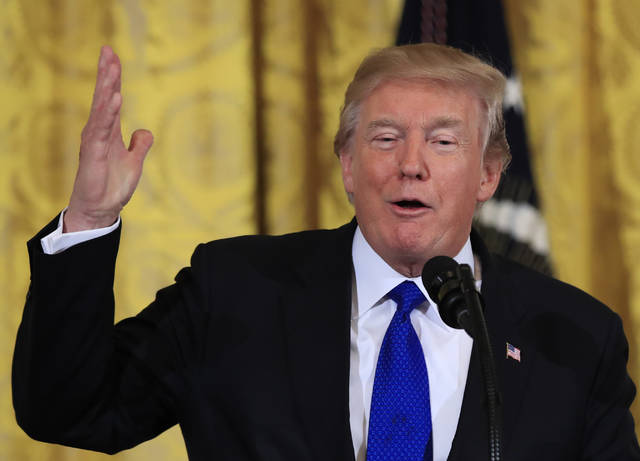WASHINGTON — The Trump administration will soon release its long-anticipated public works plan, trying to fulfill a campaign pledge but set to fall short of some ambitious goals.
As a candidate, Donald Trump promised to generate at least $1 trillion in infrastructure spending. As president, he is relying on state and local governments to pony up a significant share of the total.
Trump told mayors at the White House this week that he would present his proposal after Tuesday’s State of the Union address.
“We’re also working to rebuild our crumbling infrastructure by stimulating a $1 trillion investment, and that’ll actually probably end up being about $1.7 trillion,” Trump said.
Officials said Washington’s commitment will be far smaller — and the benefits contingent in large part on state and local support.
The administration’s plan calls for $200 billion in federal spending over 10 years, according to a six-page summary reviewed by The Associated Press.
The summary, widely and unofficially disseminated in the capital, is a snapshot of the administration’s thinking. While details may change, the broad outlines are expected to remain the same, according to officials familiar with the document. They spoke on condition of anonymity because they were not authorized to publicly discuss the internal document.
Half the money would go to grants for transportation, water, flood control, cleanup at some of the country’s most polluted sites and other projects.
States, local governments and other project sponsors could use the grants for no more than 20 percent of the cost. That’s consistent with comments from administration officials that they want to use federal dollars as incentives, and that most of rest of the money would come from other sources.
The summary also includes $14 billion over 10 years for current programs that use taxpayer money to attract private investment or lower financing costs.
White House spokeswoman Lindsay Walters said Trump and his team “are ready to work with Congress to move legislation forward quickly. America shouldn’t have to wait any longer for better infrastructure.”
Congress, however, is already bogged down on immigration and the budget, so the prospects seem slim for approving major new spending before the November elections.
One uncertainty is whether project sponsors could combine grant money with other federal sources such as highway and transit aid programs.
Transit agencies generally count on the federal government for half the cost of major construction projects, and federal dollars can make up as much as 80 percent of some highway projects.
One of the largest projects is the New York-New Jersey Gateway program, which includes building a $13 billion rail tunnel under the Hudson River. The states want Washington to pay half, but they are getting the cold shoulder from the Transportation Department.
Public works spending was viewed as a potential area of bipartisan compromise when Trump took office. But first came efforts to repeal the Obama-era health plan and overhaul taxes.
One-quarter of the expected total, $50 billion, would go toward rural projects — transportation, broadband, water, waste, power, flood management and ports. That is intended to address criticism from some Republican senators that the administration’s initial emphasis on public-private partnerships would do little to help rural, GOP-leaning states.
Under such financing ventures, private investors generally put up much of the construction costs in exchange for a share of revenue after the project is completed. Toll roads are the most common example.
But rural areas usually don’t generate enough traffic to make toll roads or other public work projects profitable.
Past attempts to designate infrastructure dollars in ways that favor either rural or urban areas have often prompted political fights.
The administration is not saying where it expects to find the $20 billion a year to pay for the plan, beyond unspecified budget cuts.
The new budget proposal, due next month, is expected to mirror the blueprint from last year, when the new administration proposed cutting billions from programs that benefit state and local government services, particularly urban centers.
Local officials say those shortfalls would make it more difficult to come up with the infrastructure spending Trump is counting on.
The plan also is silent on what the administration would do about the Highway Trust Fund, which finances most highway and transit projects. It is forecast to go broke in 2021.
Requiring states and localities to pick up 80 percent of the cost of highway projects, as the Trump plan proposes, is a fundamental shift of responsibility for infrastructure away from the federal government, said Chris Spear, president of the American Trucking Associations.
“You are now asking states to pick up the lion’s share,” he said. “That’s not going to sell.”


